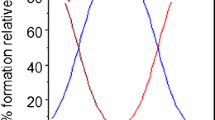Abstract
A method is described that permits the covalent attachment of enzymes to solid matrices in the presence of saturating levels of a specific substrate under conditions where the enzyme is optimally active. Bovine trypsin immobilized on glass and agarose in the presence of saturating levels of N-α-benzoyl-L-arginine ethyl ester differs in a number of respects from the enzyme bound in the absence of substrate. Trypsin bound in the presence of substrate (ES form) is attached to porous glass through three more side chains than the enzyme coupled in the absence of substrate (E form). The rate of inactivation by iodoacetamide for the ES form is much greater than that for the E form. The two enzyme forms differ also in their reactivity with TLCK and DFP, active site-directed inhibitors. The pH dependences of the ES and the E forms bound to agarose differ; the pH optima are 9.0 and 8.5 for the ES and E forms, respectively. The thermal denaturation of the agarose-trypsins occurs in two distinct steps. The inactivation rate of the ES form is significantly slower than the E form in both stages. Also, for the hydrolysis of both N-α-benzoyl-L-arginine ethyl ester and N-α-benzoyl-Larginine amide, the Km values for the ES form were lower than the Km values for the E form. Our data suggest that a substrate-induced conformatonal change occurs with trypsin, and that this conformation is stabilized when the enzyme is bound by multiple attachments to a solid support. These findings support the “induced-fit” theory in general and lend support to the interpretation of the activation of trypsin by methyl guanidine that is part of a specific substrate (Inagami, T., and Hatano, H. [1969] J. Biol. Chem. 244, 1176).
Similar content being viewed by others
References
Bernhard, S. A., andGutfreund, H. (1958) Proc. Intern. Symp, Enzyme Chem. Tokyo-Kyoto, p. 124.
Spencer, T., andSturtevant, J. M. (1959) J. Am. Chem. Soc. 81: 1874–1882.
Hein, G. E., andNiemann, (1962) J. Am. Chem. Soc. 84: 4495–4503.
Niemann, G (1964) Science 143: 1287–1296.
Hamilton, C. L., Niemann, C, andHammond, G. S. (1966) Proc. Natl. Acad. Sci. U.S.A. 55: 664–669.
Koshland, D. E., Jr. (1958) Proc. Nat. Acad. Sci. U.S.A. 44: 98–104.
Thomas, J. A., andKoshland, D. E., Jr. (1960) J. Am. Chem. Soc. 82: 3329–3333.
Koshland, D. E., Jr. (1970) Adv. Enzymol. 22: 45–97.
Koshland, D. E., Jr., andNeet, K. E. (1968) Annu. Rev. Biochem. 37: 359–410.
Inagami, T., andMurachi, T. (1964) J. Biol. Chem. 239: 1395–1401.
Inagami, T., andHatano, H. (1969) J. Biol. Chem. 244:1176–1182.
Walsh, K. A., andNeurath, H. (1964) Proc. Natl. Acad. Sci. U.S.A. 52: 884–889.
Royer, G. P., andGreen, G. M. (1971) Biochem. Biophys. Res. Commun. 44: 426- 432.
Cuatrecases, P. (1970) J. Biol. Chem. 245: 3059–3065.
Gutfreund, H. (1955) Trans. Faraday Soc. 51: 441–446.
Royer, G. P., andUy, R. (1973) J. Biol. Chem. 248: 2627–2629.
Feiser, L. F., andFeiser, M. (1967) In Reagents for Organic Synthesis, John Wiley and Sons, New York, p. 393.
Lee, P. P., andWestheimer, H. G. (1966) Biochemistry 5: 834–837.
Beeley, J. G., andNeurath, H. (1968) Biochemistry 7: 1239–1251.
Knights, R. J., andLight, A. (1974) Arch. Biochem. Biophys. 160: 377–386.
Kasche, V., Lundquist, H., Bergman, R., andAxen, R. (1971) Biochem. Biophys. Res. Commun. 45: 615–621.
Lilly, M. D., Hornby, W. E., andCrook, E. M. (1966) Biochem J. 100: 718–724.
Keyes, M. H., andSemersky, F. E. (1972) Abstract No. B101.007, 164th Meeting of the American Chemical Society, New York.
Wilkinson, G. M. (1961) Biochem. J. 80: 324–329.
Moore, S. (1968) J. Biol. Chem. 243: 6281–6283.
Shaw, E., andSpringhorn, S. (1967) Biochem. Biophys. Res. Commun. 27: 391–397.
Laidler, K. J., andBunting, P. S. (1973) In The Chemical Kinetics of Enzyme Action, Clarendon Press, Oxford, p. 416.
Stroud, R. M., Kay, L. M., andDickerson, R. E. (1971) Cold Spring Harbor Symp. Quant. Biol. 36:125–140.
Villaneuva, G. B., andHerskovits, T. T. (1971) Biochemistry 10: 4589–4594.
Villaneuva, G. B., andHerskovits, T. T. (1971) Biochemistry 10: 3358–3365.
Fink, A. L. (1974) J. Biol. Chem. 249: 5027–5032.
Goldman, R., andKatchalski, E. (1971) In Stark, G. R. (ed.), Biochemical Aspects of Reactions on Solid Supports, Academic Press, New York, p. 59.
Thomas, D., Brown, G., andSelegny, E. (1972) Biochimie 54: 229.
Bunting, P. S., andLaidler, K. J. (1972) Biochemistry 11: 4477.
Author information
Authors and Affiliations
Rights and permissions
About this article
Cite this article
Uy, R., Liu, V.S.H. & Royer, G.P. Evidence for the induction of a conformational change of trypsin by a specific substrate at pH 8.0. Journal of Solid-Phase Biochemistry 1, 51–65 (1976). https://doi.org/10.1007/BF03006136
Accepted:
Issue Date:
DOI: https://doi.org/10.1007/BF03006136




